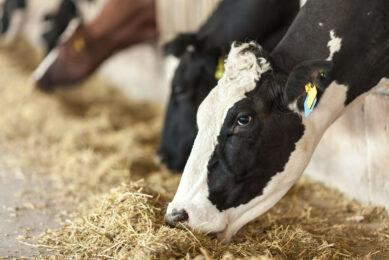Energy to protein ratio of several forage mixtures

The energy to protein ratio of forages affects ruminant N use efficiency but little is known on its variation among legume–grass complex mixtures. The objective of the research was to determine the variation in the ratio of forage readily-available energy to proteins along with the associated variation in yield and digestibility by mixing three or four grass species in combination with one of two legume species.
Four grass mixes [#1 – timothy (Phleum pratense L.), meadow fescue (Festuca elatior L.), and Kentucky bluegrass (Poa pratensis L.); #2 – timothy, meadow fescue, reed canarygrass (Phalaris arundinacea L.), and Kentucky bluegrass; #3 – tall fescue [Schedonorus phoenix (Scop.) Holub], meadow bromegrass (Bromus biebersteinii Roemer & J.A. Schultes), orchardgrass (Dactylis glomerata L.), and Kentucky bluegrass; #4 – tall fescue, meadow bromegrass, reed canarygrass, and Kentucky bluegrass] were grown with either alfalfa (Medicago sativa L.) or birdsfoot trefoil (Lotus corniculatus L.) at two sites with measurements taken on two simulated grazing events of the first post-establishment year.
The water soluble carbohydrate (WSC) to crude protein (CP) ratio among the eight legume–grass mixtures ranged from 0.64 to 1.04, while the ratio of readily fermentable carbohydrate fractions A and B1 to readily soluble protein fractions A and B1 [(CA + CB1)/(PA + PB1)], estimated using the Cornell net carbohydrate and protein system, ranged from 4.33 to 5.64.
This significant variation in the two ratios used to characterise the energy to protein balance was due to both legume species and grass mixes. Alfalfa-based complex mixtures had greater WSC/CP and (CA + CB1)/(PA + PB1) than birdsfoot trefoil-based mixtures (0.94 vs. 0.69; 5.42 vs. 4.47) but a lower in vitro true digestibility (IVTD; 902 vs. 913 g/kg dry matter, DM). The grass species mix #2 (timothy, meadow fescue, reed canarygrass, and Kentucky bluegrass) provided the best combination of high readily-available energy to protein ratio (WSC/CP = 0.87; (CA + CB1)/(PA + PB1) = 5.08), high DM yield, and average IVTD. The complex mixtures including alfalfa and meadow fescue had the best readily-available energy to protein ratio and DM yield.
Our results confirm the possibility of improving the balance between readily-available energy and proteins through the choice of species in complex mixtures made of one legume and three or four grass species.
To read more please visit the Science Direct website .
This has been taken from a paper issued in the Animal Feed Science and Technology Volume 188, February 2014.
Forage energy to protein ratio of several legume–grass complex mixtures
Michele Simili da Silva, Gaëtan F. Tremblay, Gilles Bélanger, Julie Lajeunesse, Yousef A. Papadopoulos, Sherry A.E. Fillmore, Clóves Cabreira Jobim











